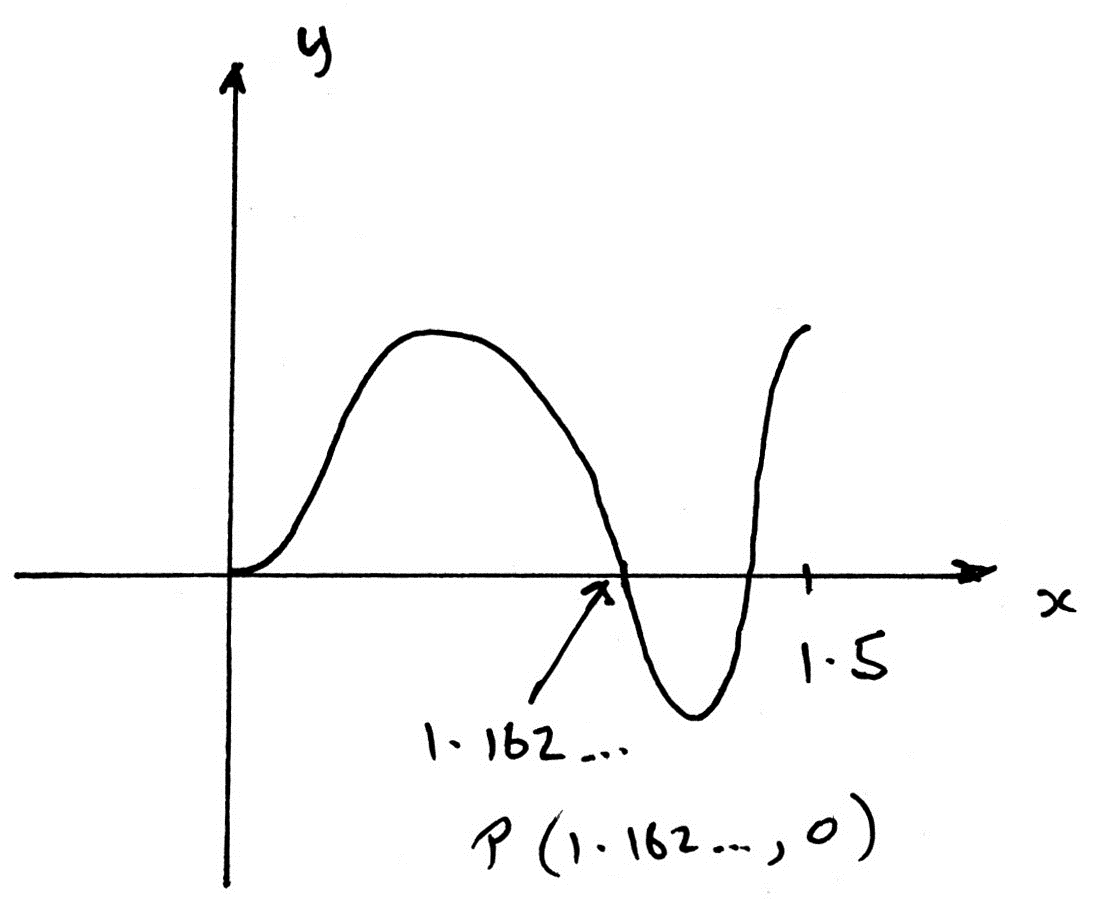Question
A.Prove by mathematical induction that, for \(n \in {\mathbb{Z}^ + }\),
\[1 + 2\left( {\frac{1}{2}} \right) + 3{\left( {\frac{1}{2}} \right)^2} + 4{\left( {\frac{1}{2}} \right)^3} + … + n{\left( {\frac{1}{2}} \right)^{n – 1}} = 4 – \frac{{n + 2}}{{{2^{n – 1}}}}.\][8]
(b) Solve the differential equation \(\frac{{{\text{d}}y}}{{{\text{d}}x}} = \sqrt {1 – {y^2}} {{\text{e}}^{2x}}\sin x\), given that y = 0 when x = 0,
writing your answer in the form \(y = f(x)\) .
(c) (i) Sketch the graph of \(y = f(x)\) , found in part (b), for \(0 \leqslant x \leqslant 1.5\) .
Determine the coordinates of the point P, the first positive intercept on the x-axis, and mark it on your sketch.
(ii) The region bounded by the graph of \(y = f(x)\) and the x-axis, between the origin and P, is rotated 360° about the x-axis to form a solid of revolution.
Calculate the volume of this solid.[17]
▶️Answer/Explanation
Markscheme
prove that \(1 + 2\left( {\frac{1}{2}} \right) + 3{\left( {\frac{1}{2}} \right)^2} + 4{\left( {\frac{1}{2}} \right)^3} + … + n{\left( {\frac{1}{2}} \right)^{n – 1}} = 4 – \frac{{n + 2}}{{{2^{n – 1}}}}\)
for n = 1
\({\text{LHS}} = 1,{\text{ RHS}} = 4 – \frac{{1 + 2}}{{{2^0}}} = 4 – 3 = 1\)
so true for n = 1 R1
assume true for n = k M1
so \(1 + 2\left( {\frac{1}{2}} \right) + 3{\left( {\frac{1}{2}} \right)^2} + 4{\left( {\frac{1}{2}} \right)^3} + … + k{\left( {\frac{1}{2}} \right)^{k – 1}} = 4 – \frac{{k + 2}}{{{2^{k – 1}}}}\)
now for n = k +1
LHS: \(1 + 2\left( {\frac{1}{2}} \right) + 3{\left( {\frac{1}{2}} \right)^2} + 4{\left( {\frac{1}{2}} \right)^3} + … + k{\left( {\frac{1}{2}} \right)^{k – 1}} + (k + 1){\left( {\frac{1}{2}} \right)^k}\) A1
\( = 4 – \frac{{k + 2}}{{{2^{k – 1}}}} + (k + 1){\left( {\frac{1}{2}} \right)^k}\) M1A1
\( = 4 – \frac{{2(k + 2)}}{{{2^k}}} + \frac{{k + 1}}{{{2^k}}}\,\,\,\,\,\)(or equivalent) A1
\( = 4 – \frac{{(k + 1) + 2}}{{{2^{(k + 1) – 1}}}}\,\,\,\,\,\)(accept \(4 – \frac{{k + 3}}{{{2^k}}}\)) A1
Therefore if it is true for n = k it is true for n = k + 1. It has been shown to be true for n = 1 so it is true for all \(n{\text{ }}( \in {\mathbb{Z}^ + })\). R1
Note: To obtain the final R mark, a reasonable attempt at induction must have been made.
[8 marks]
(a)
METHOD 1
\(\int {{{\text{e}}^{2x}}\sin x{\text{d}}x = – \cos x{{\text{e}}^{2x}} + \int {2{{\text{e}}^{2x}}\cos x{\text{d}}x} } \) M1A1A1
\( = – \cos x{{\text{e}}^{2x}} + 2{{\text{e}}^{2x}}\sin x – \int {4{{\text{e}}^{2x}}\sin x{\text{d}}x} \) A1A1
\(5\int {{{\text{e}}^{2x}}\sin x{\text{d}}x = – \cos x{{\text{e}}^{2x}} + 2{{\text{e}}^{2x}}\sin x} \) M1
\(\int {{{\text{e}}^{2x}}\sin x{\text{d}}x = \frac{1}{5}{{\text{e}}^{2x}}(2\sin x – \cos x) + C} \) AG
METHOD 2
\(\int {\sin x{{\text{e}}^{2x}}{\text{d}}x = \frac{{\sin x{{\text{e}}^{2x}}}}{2} – \int {\cos x\frac{{{{\text{e}}^{2x}}}}{2}{\text{d}}x} } \) M1A1A1
\( = \frac{{\sin x{{\text{e}}^{2x}}}}{2} – \cos x\frac{{{{\text{e}}^{2x}}}}{4} – \int {\sin x\frac{{{{\text{e}}^{2x}}}}{4}{\text{d}}x} \) A1A1
\(\frac{5}{4}\int {{{\text{e}}^{2x}}\sin x{\text{d}}x = \frac{{{{\text{e}}^{2x}}\sin x}}{2} – \frac{{\cos x{{\text{e}}^{2x}}}}{4}} \) M1
\(\int {{{\text{e}}^{2x}}\sin x{\text{d}}x = \frac{1}{5}{{\text{e}}^{2x}}(2\sin x – \cos x) + C} \) AG
[6 marks]
(b)
\(\int {\frac{{{\text{d}}y}}{{\sqrt {1 – {y^2}} }} = \int {{{\text{e}}^{2x}}\sin x{\text{d}}x} } \) M1A1
\(\arcsin y = \frac{1}{5}{{\text{e}}^{2x}}(2\sin x – \cos x)( + C)\) A1
when \(x = 0,{\text{ }}y = 0 \Rightarrow C = \frac{1}{5}\) M1
\(y = \sin \left( {\frac{1}{5}{{\text{e}}^{2x}}(2\sin x – \cos x) + \frac{1}{5}} \right)\) A1
[5 marks]
(c)
(i)  A1
A1
P is (1.16, 0) A1
Note: Award A1 for 1.16 seen anywhere, A1 for complete sketch.
Note: Allow FT on their answer from (b)
(ii) \(V = \int_0^{1.162…} {\pi {y^2}{\text{d}}x} \) M1A1
\( = 1.05\) A2
Note: Allow FT on their answers from (b) and (c)(i).
[6 marks]
Question
a.Find \(\int {x{{\sec }^2}x{\text{d}}x} \).[4]
b.Determine the value of m if \(\int_0^m {x{{\sec }^2}x{\text{d}}x = 0.5} \), where m > 0.[2]
▶️Answer/Explanation
Markscheme
\(\int {x{{\sec }^2}x{\text{d}}x} = x\tan x – \int {1 \times \tan x{\text{d}}x} \) M1A1
\( = x\tan x + \ln \left| {\cos x} \right|( + c){\text{ }}\left( { = x\tan x – \ln \left| {\sec x} \right|( + c)} \right)\) M1A1
[4 marks]
attempting to solve an appropriate equation eg \(m\tan m + \ln (\cos m) = 0.5\) (M1)
m = 0.822 A1
Note: Award A1 if m = 0.822 is specified with other positive solutions.
[2 marks]